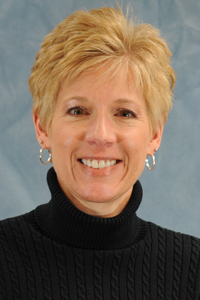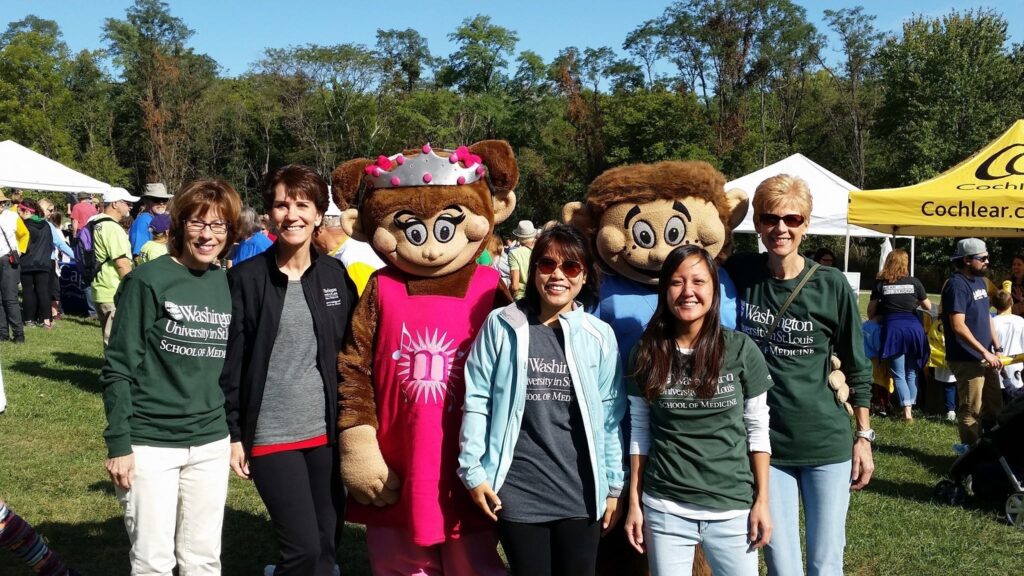Laura Holden, AuD, is a clinical audiologist and research scientist that has worked in the Department of Otolaryngology at Washington University for 34 years, most of that time with cochlear implant patients.
What caused you to choose the field of speech and hearing?
I was interested in the health care profession but really didn’t know which direction to take. I walked past the Speech and Hearing Building at the University of Illinois during my freshman year and thought that Speech and Hearing could be interesting. I took a class the following semester and very much enjoyed it.
How long have you worked for Wash U? How long in otolaryngology?
I started working at Washington University in the Department of Otolaryngology in May of 1986, two days after finishing graduate school. I worked for Mike Valente in Audiology for three years. Margo Skinner was starting the Cochlear Implant (CI) Program at that time and I began working with Margo part time.

We only had one patient who was implanted with a single channel device which made him dizzy. (He later obtained a multi-channel implant and did very well). More patients were implanted over the next few years, and Margo obtained an NIH grant in 1989. At that point, I started working with CI patients full time.
It was a very exciting time because implants were so new, and Margo and I were learning to program multichannel devices together. Margo had very keen insights into programming because she had worked with hearing aids for so long. We worked closely with researchers from Australia who developed the Nucleus Cochlear Implant.
It is rewarding to know that some of the information gained from our early research is still used to program and test CI patients today. At that time, our research primarily focused on optimizing outcomes with an implant. Margo was a terrific person to work with and I learned a lot from her. She became my friend and mentor. She passed away of lung disease in 2008.
Margo was one smart cookie; she had enough foresight, after she became ill, to recruit Jill Firszt as our next director. Jill has been the director of our CI program for many years now and holds the same beliefs in optimizing outcomes as Margo, which is one reason I love working at WU. Margo had a hand in teaching all of our current audiologists; like Margo, we are all very passionate about optimizing each patient’s hearing and understanding. It is a privilege to work with this team of CI audiologists.
What kind of research are you currently working on?
Our research has focused on asymmetric hearing loss for a number of years now. Individuals with asymmetric hearing loss have one ear with moderate to profound hearing loss and one ear with mild or moderate hearing loss. Therefore, one ear meets CI candidacy criteria, but the other ear doesn’t.
We believe that each ear should be treated with the best device to provide optimal hearing. For patients with asymmetric hearing loss, a CI may be the best device for the ear with moderate to profound hearing loss while a hearing aid is likely the best device for an ear with mild or moderate hearing loss. When we began this research, the FDA had not approved CIs for patients with asymmetric hearing loss.
Recently, the FDA has provided approval for individuals with asymmetric hearing loss as well as those with single-sided deafness; however, the approval is restrictive and limited to those with profound hearing loss in the poor hearing ear.
We hope to inform, through our research, the benefits that an implant can provide to patients with a range of hearing in the poor ear, i.e., moderate to profound hearing loss. Ultimately, we want all patients who meet CI candidacy criteria in at least one ear to have the opportunity to obtain an implant. Currently, we are the lead center for an National Institutes of Health (NIH) U01 clinical trial focusing on adults with asymmetric hearing loss. We recently received a U01 clinical trial grant for children with asymmetric hearing loss and single-sided deafness. We have a number of other research projects as well that focus on improving patients hearing with a CI.
Is there something about your work for which you are exceptionally proud? If yes, what is it and why?
In 2004, Margo initiated a longitudinal research study examining the factors that contribute to cochlear implant outcomes. We followed over 150 CI recipients for 2 years after they were implanted. Margo passed away before the study was completed. I’m very proud that our team finished the study and published the results. The paper has been well received, and I believe the results have contributed to the field.
What do you love most about your work?
We make a significant difference in our patients’ lives by improving their hearing, and hence their ability to communicate with others. Being able to help people every day is the best part of the job.
